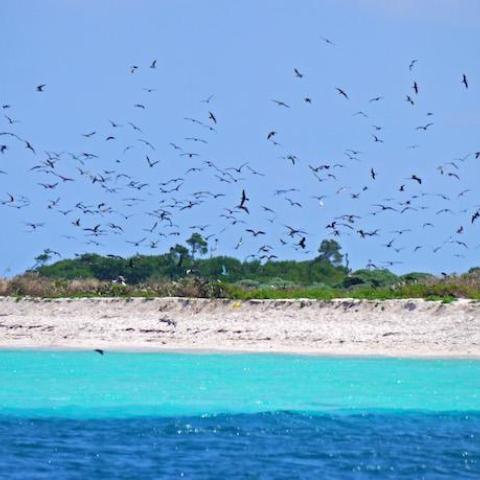
The breach in the counterscarp (moat wall) reduces the protection from storm impacts to Fort Jefferson at Dry Tortugas National Park/NPS
Work to repair a moat wall at Dry Tortugas National Park in Florida will spur a 45-day closure of the Garden Key Campground later this spring.
The dredging and moat wall repair project is set to begin March 11. The National Park Service said that with multiple phases, this project will repair, strengthen, and protect historic Fort Jefferson, a 19th century fort located in the Gulf of Mexico, 70 miles from Key West. Once the work begins, the campground will be closed for 45 days for visitor safety. It is expected to reopen April 25.
“This project is vital to safeguard historic Fort Jefferson. Without the protection of the moat wall and a functioning moat, the next storm may severely damage the fort itself,” said Park Manager James Crutchfield. “While we know that this project will greatly impact our camping visitors who have planned their trip months in advance, the safety of our visitors is our highest priority.”
The project will repair and strengthen the sections of the Fort Jefferson counterscarp (moat wall) damaged by Hurricane Irma in 2017 and Hurricane Ian in 2022 and restore water flow in the moat by removing sand and sediment that accumulated in two locations near North Beach and South Beach. Dredging of the finger piers will also reestablish recreational and park use of the dock and slips at the Garden Key waterfront. The proposed repairs and dredging are supported by construction funds allocated through Public Law 115-123 for national park units impacted by Hurricanes Harvey, Irma, and Maria.
The first phase will remove the sand and sediment deposited by storms in the moat and around the finger piers used by visitors and NPS boats. After removing debris, including bricks and other hazards, the sand will be redistributed in the parade ground and along the shoreline and beaches of Garden Key.
Because of the location of the sand deposits and the heavy construction equipment needed to remove it from the moat, the campground will be closed for 45 days for the safety of park visitors, staff and the construction crew. After the closure, campers may still experience the impacts of ongoing construction in the area, including noise from the machinery. The park’s goal is to reopen the campground in time for Grouper Season and Memorial Day weekend.
South Beach will also be closed to swimming and snorkeling during this period. The grounds from the dock to Fort Jefferson will be used for staging and cleaning the dredging material before redistributing it on South Beach. During this time, North Beach will remain open for visitor recreation. When the work at South Beach is completed, the temporary closure will switch to the North Beach side and South Beach will reopen to ensure continuous access to the water around the Fort for park visitors.
The second phase of the project will repair breaches in the moat wall caused by storms and strengthen the existing counterscarp. The entire project is scheduled for completion by fall 2024.
The park’s authorized concessioner, Yankee Freedom III, is offering alternate arrangements for ferry passengers with camping reservations during this time, including rescheduling, changing to a day visit, or refunding their trip. For specifics, contact the Dry Tortugas Ferry concessioner, Yankee Freedom III at 800-634-0939.
Construction activity will cause noise and visual impacts for day trip visitors traveling by seaplane, ferry, and private boat. The park is working closely with the contractor to ensure maximum safe access to Garden Key and Fort Jefferson for all visitors.
Dry Tortugas National Park is located about 70 miles west of Key West and encompasses seven keys, collectively known as the Dry Tortugas. Fort Jefferson, a 19th century American masonry coastal fort, was constructed in 1846 and served to protect shipping access to the Gulf of Mexico. Garden Key where the fort is located is the primary destination for people visiting the park. The 14-acre island is home to the park’s visitor center, administrative areas, docking and mooring, campground and beaches.



 Support Essential Coverage of Essential Places
Support Essential Coverage of Essential Places






